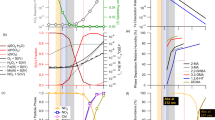Abstract
THE ‘aerosol layers’ frequently observed at about 50 km altitude may be due to downward transport from above of particulates, possibly of extraterrestrial origin. This transport would be more efficient at higher altitudes (the mesosphere) than lower altitudes (the stratosphere) thus causing the layering seen in the stratopause region. The flux of particulates through the stratosphere provides a potential scavenging mechanism for pollutants and a source of condensation nucleii to the troposphere. Electric field variations, probably induced from above, can modulate this flux, providing a possible coupling mechanism between geomagnetic activity and terrestrial weather. The particulate distribution is also affected by the general circulation and atmospheric dynamics. The density of particulates is much greater than generally recognised, indicating that their role in chemical and thermal processes should be reassessed.
This is a preview of subscription content, access via your institution
Access options
Subscribe to this journal
Receive 51 print issues and online access
$199.00 per year
only $3.90 per issue
Buy this article
- Purchase on Springer Link
- Instant access to full article PDF
Prices may be subject to local taxes which are calculated during checkout
Similar content being viewed by others
References
Bourdeau, R. E., Whipple, E. C., Jr & Clark, J. F. J. geophys. Res. 61, 1363 (1959).
Widdel, H. U., Rose, G. & Borschers, R. Pure appl. Geophys. 84, 154 (1971).
Bragin, Yu. A. Nature 245, 450 (1973).
Chesworth, E. T. & Hale, L. C. Geophys. Res. Lett. 1, 347 (1974).
Croskey, C. L., Hale, L. C. & Leiden, S. C. Space Res. 17, (in the press).
Mitchell, J. D., Sagar, R. S. & Olsen, R. O. Space Res. 17, (in the press).
Narcisi, R. S., Bailey, A. D., Wlodyka, L. E. & Philbrick, C. R. J. atmos. terr. Phys. 34, 647 (1972).
Giovane, F., Schuerman, D. W. & Greenberg, J. M. J. geophys. Res. 81, 5383 (1976).
Kellogg, W. W. Space Sci. Rev. 3, 275 (1964).
George, J. D., Zimmerman, S. P. & Keneshea, T. J. Space Res. 12, 695 (1972).
Dolezak, H. Pure appl. Geophys. 84, 9 (1971).
Tyutin, A. A. Cosmic Res. 14, 132 (1976).
Castleman, A. W., Space Sci. Res. 15, 547 (1974).
Hirono, M., Fujiwara, M. & Itabe, T. J. geophys. Res. 81, 1593 (1976).
Hunten, D. M. Geophys. Res. Lett. 2, 26 (1975).
Reiter, R. J. atmos. terr. Phys. 39, 95 (1977).
Roberts, W. O. & Olson, R. H. J. atmos. Sci. 30, 135 (1973).
Dickinson, R. E. Bull. Am. met. Soc. 56, 1240 (1975).
Houghton, J. T. Presidential Address, Royal met. Soc. (1977).
Author information
Authors and Affiliations
Rights and permissions
About this article
Cite this article
HALE, L. Particulate transport through the mesosphere and stratosphere. Nature 268, 710–711 (1977). https://doi.org/10.1038/268710a0
Received:
Accepted:
Issue Date:
DOI: https://doi.org/10.1038/268710a0
This article is cited by
Comments
By submitting a comment you agree to abide by our Terms and Community Guidelines. If you find something abusive or that does not comply with our terms or guidelines please flag it as inappropriate.



